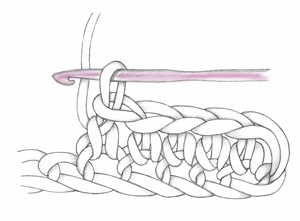Technical editor and yarncrafting expert Kj Hay returns to share tips on finishing your crochet projects. Join her next month for tips on finishing your knitting project. Click here to see her previous blog post.

Weaving in well is so very important. If your ends are not woven in well, your ends could come loose and stick out making your piece look messy. Or worse, your work could come unraveled when the piece is used or laundered. There are two very important things to remember for successful weaving in; 1) Leave a long tail, 2) Always weave the tail in more than one direction.
Always leave a long tail, at least 6″. When cutting the yarn, it is no time to be stingy. Cutting your tails short will not save you much money and is likely to cause you a great deal of frustration.
Leaving a long tail is a cheap thrill. An average ball of acrylic yarn measures about 170 yds and costs about $4.39. There are 170 × 36 = 6,120 inches in this average ball. So, a 6″ tail of yarn costs you about ($4.39 ÷ 6,120) × 6 = $0.0043, that’s less than ½ of a penny. So, live a little, even splurge on an occasional 12″ tail for less than a penny.
A long tail has many, many advantages. Long tails make weaving in much easier. You have plenty of length to thread the tail onto the needle and weave back and forth under your stitches. Who hasn’t struggled with threading the fraying end of a too short tail into a yarn needle, only to have it pop right back out of the needle the first time you try to insert the needle into your work? Long tails can be used to seam pieces together, and sew buttons or embellishments in place without having to introduce a separate piece of yarn. This reduces the number of ends to weave in. It is wise to never cut a tail short until you are certain you will not want it to help seam pieces together or attach embellishments.
When you weave in your tails, thread the tail onto a yarn needle and insert the needle underneath the stitches in the last row or round for several inches. Take a small stitch around the last stitch woven under, and weave the tail back in the opposite direction under the same stitches. Weaving in at least two directions significantly reduces the chances that the yarn tails will work loose when the piece is used and laundered. Many people use the time-saving technique of working stitches over the ends of yarn when a new ball or color is introduced. This is a great technique, but for best results, still leave a good length of the tail(s) uncovered and use a needle to weave them back in the opposite direction.
Despite your best efforts, you find yourself with a too short tail. What can you do?
For more articles by Kj Hay, click here.
You must be <a href="https://blog.lionbrand.com/wp-login.php?redirect_to=https%3A%2F%2Fblog.lionbrand.com%2Fgreat-endings-to-your-crochet-project-pt-2-weaving-in%2F">logged in</a> to post a comment.
Great Endings to Your Crochet Project, Pt. 3: Edging | Lion Brand Notebook
[…] finishing your crochet projects. Join her next month for tips on finishing your knitting project. Click here to yesterday’s blog post; click here to see Sunday’s blog […]
Jennifer S. Williams
These are awesome tips. I had never thought about the fabric glue; now I won’t have to worry about the fuzzy ends peeking through, no matter what I do. Love it!
longtime6
Excellent tips…it took me 50 years to come to the same conclusions as these tips . Then, I even learned some more by reading here..
Barbara
I’m going to check out the fabric glue — have never used it but I’ll try it — after all the time spent on the project, would be a shame to have it come apart (especially by the user who may not know how to crochet). Thanks for the tip.
Ellen
weave in ends and put a tacking stitch to hold forever with matching thread,
Jacinta
That’s what my grandmother taught me. 🙂
Lois A Sweet-Friedman
What do you do when woven in ends come out?
Lois A Sweet-Friedman
Just saw the note about fabric glue. Is that ok for babies?
Rebecca
Do you have any suggestions for weaving in ends when you are dealing with variegated yarn? In many cases you would be weaving an end into a section of a different color.
Sid Melucci
Sometimes–not always, but SOMETIMES–you can start off by weaving down a couple of rows until you reach a place that matched the tail.
Sandiesan
Does anyone else not mess with the yarn needle? I just take a smaller crochet hook and “weave” my ends in with it. It’s a lot faster. I still make sure to go several different directions to make sure they’re secure.
Jacinta
I don’t know if it’s faster – LOL – because I’ve never tried it with a needle. I always do what you do – sometimes I don’t even use a smaller hook. I just work with the hook I used for the piece and “weave” up, down, around, under & through stitches. That’s the way my grandmother taught me.
Lori Anne MacKenzie
I’ve also read that using clear nail polish is a good way to secure the finish, especially with fibers that are thin and glossy, and tend to unravel no matter how securely you try to weave the ends in. I haven’t tried it myself, so I don’t know how it stands up to laundering and wear.
Jane
Another reason for leaving an extra long tail- if you ever need to do a small repair down the road you know where to find a small length